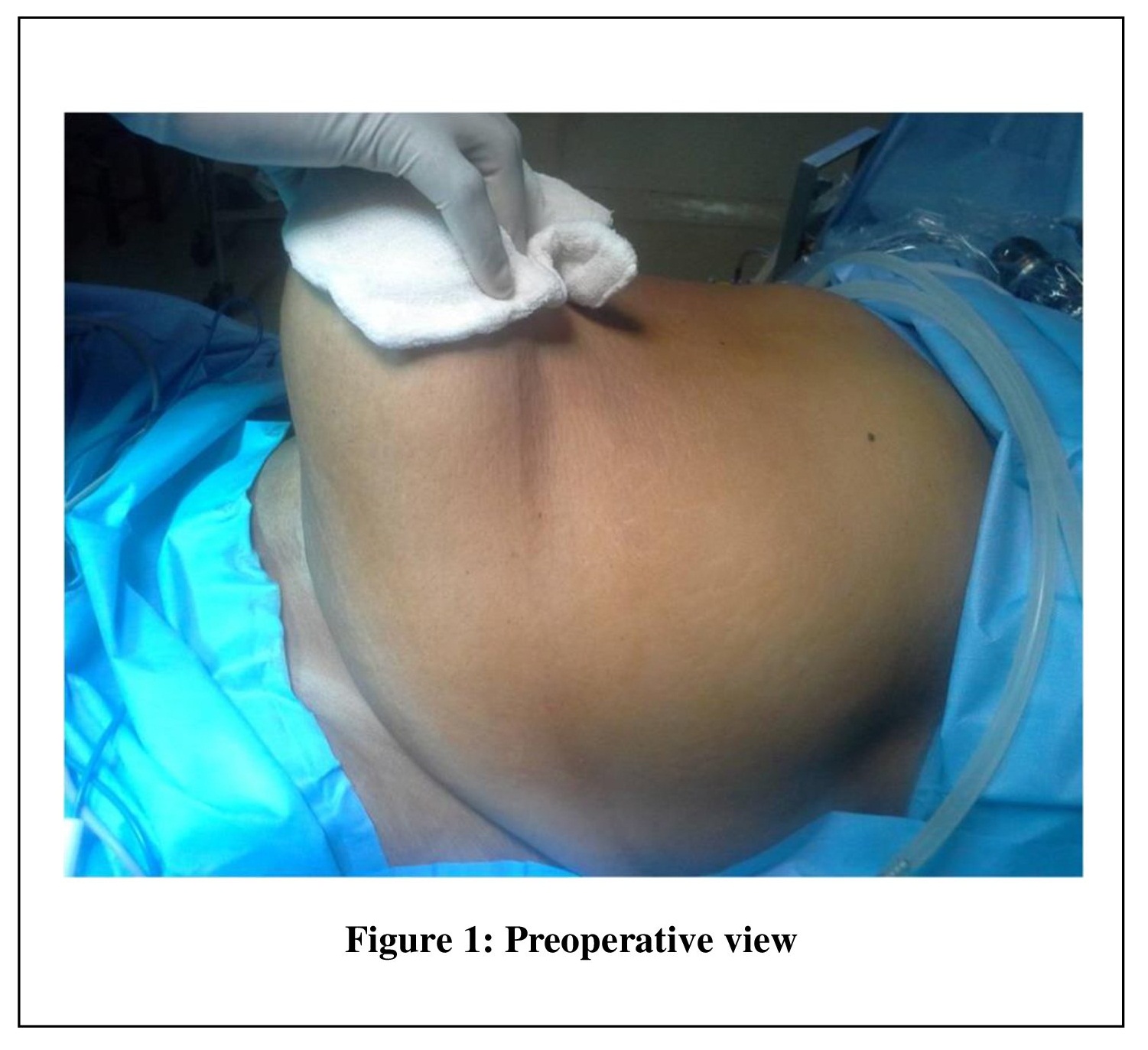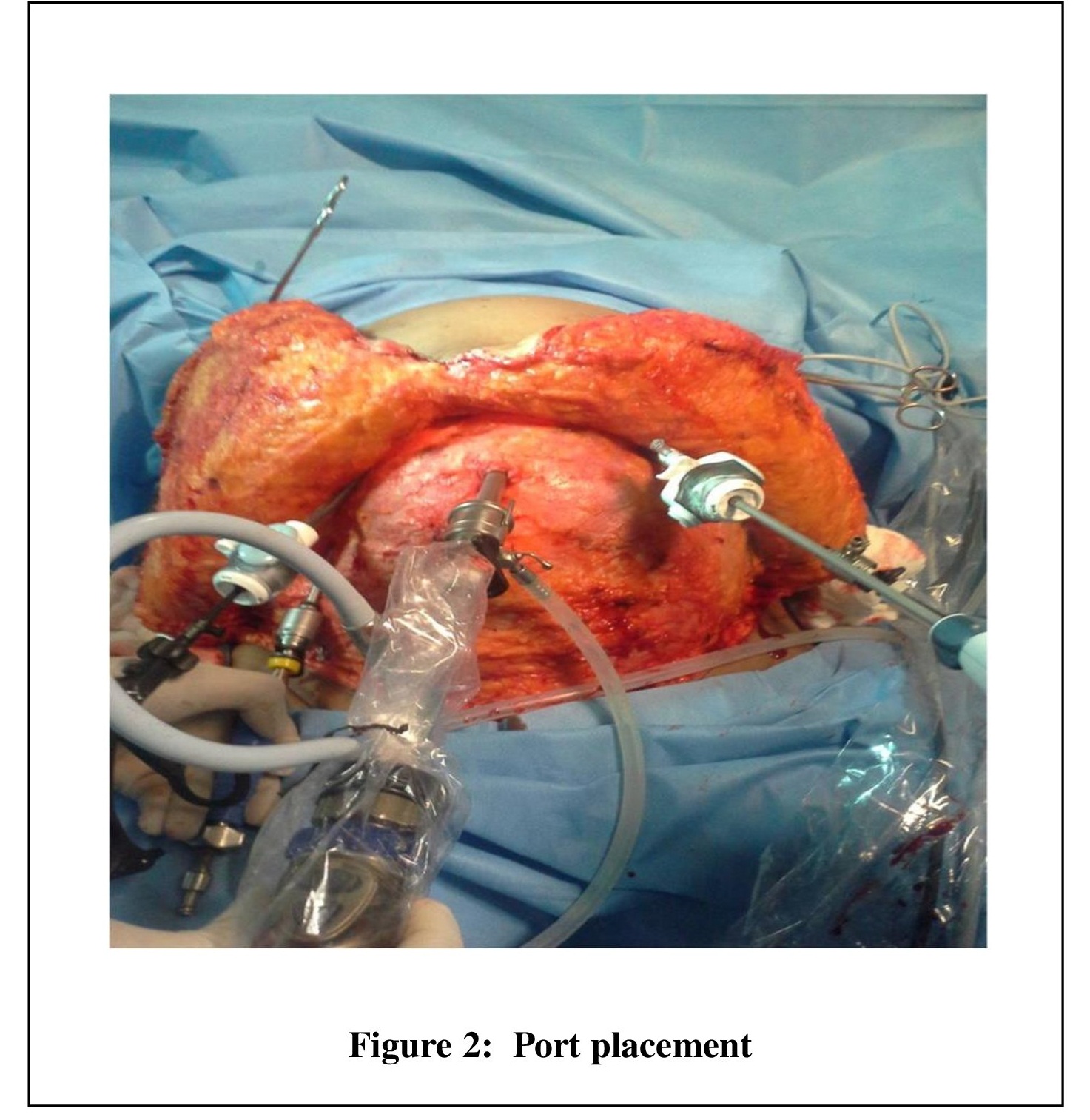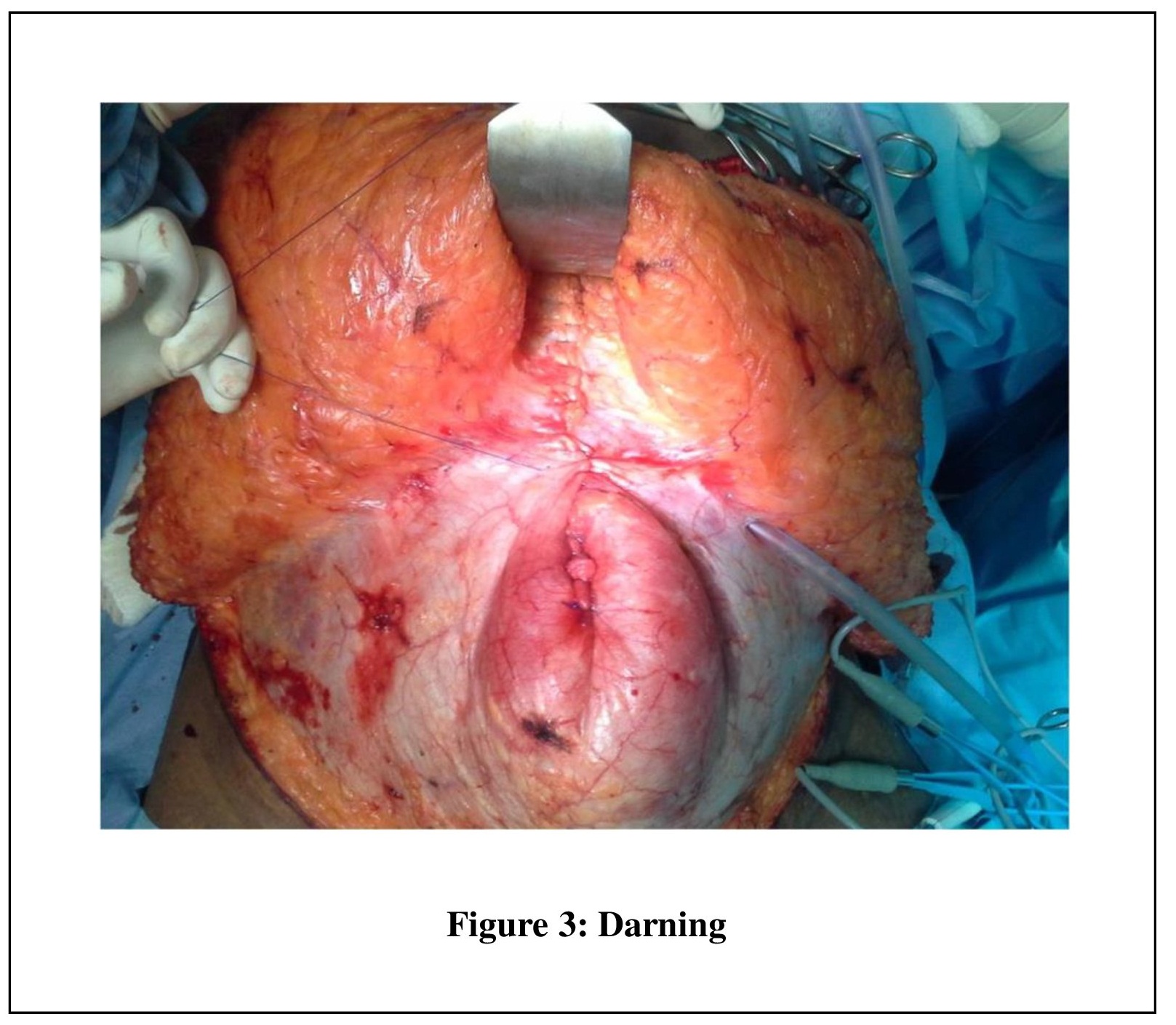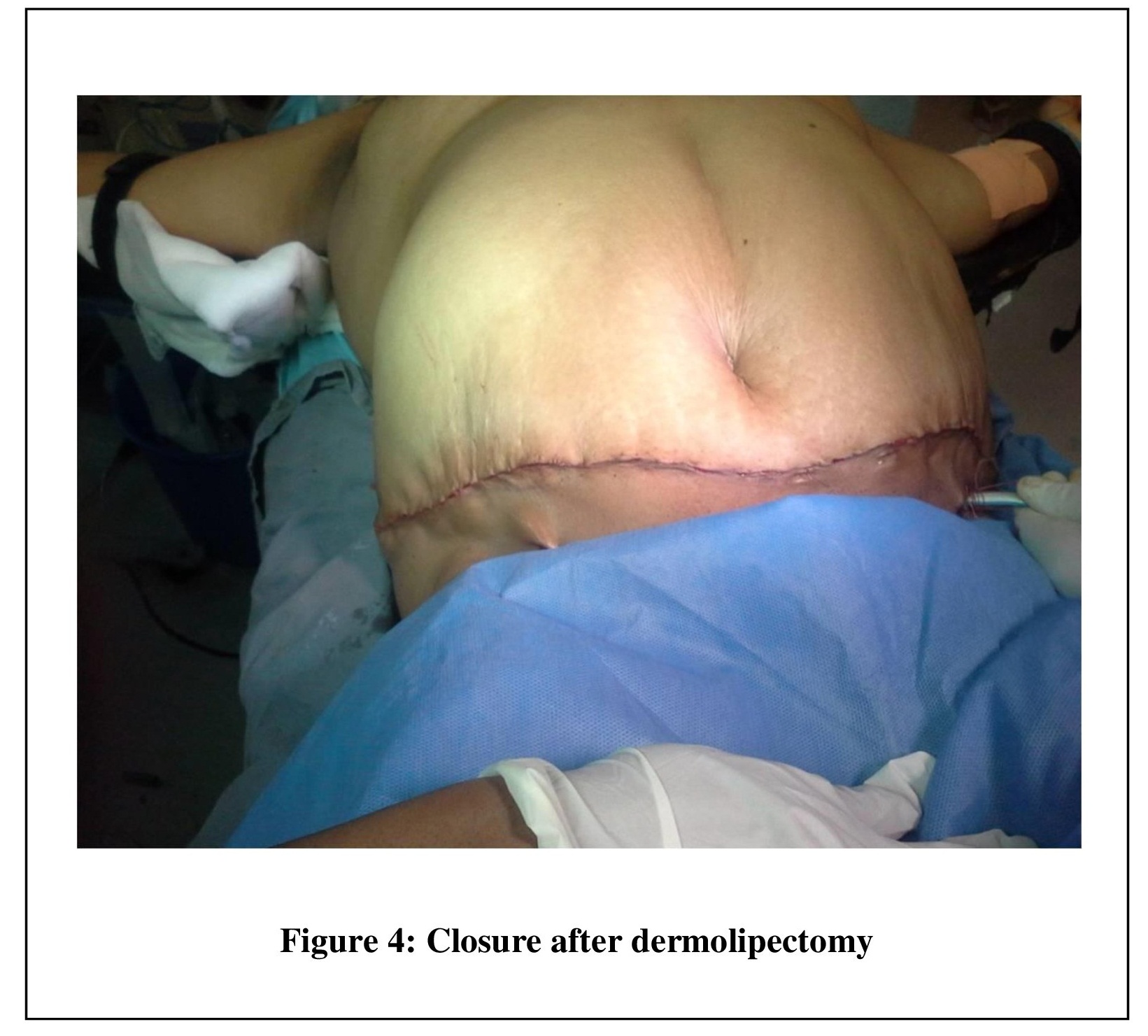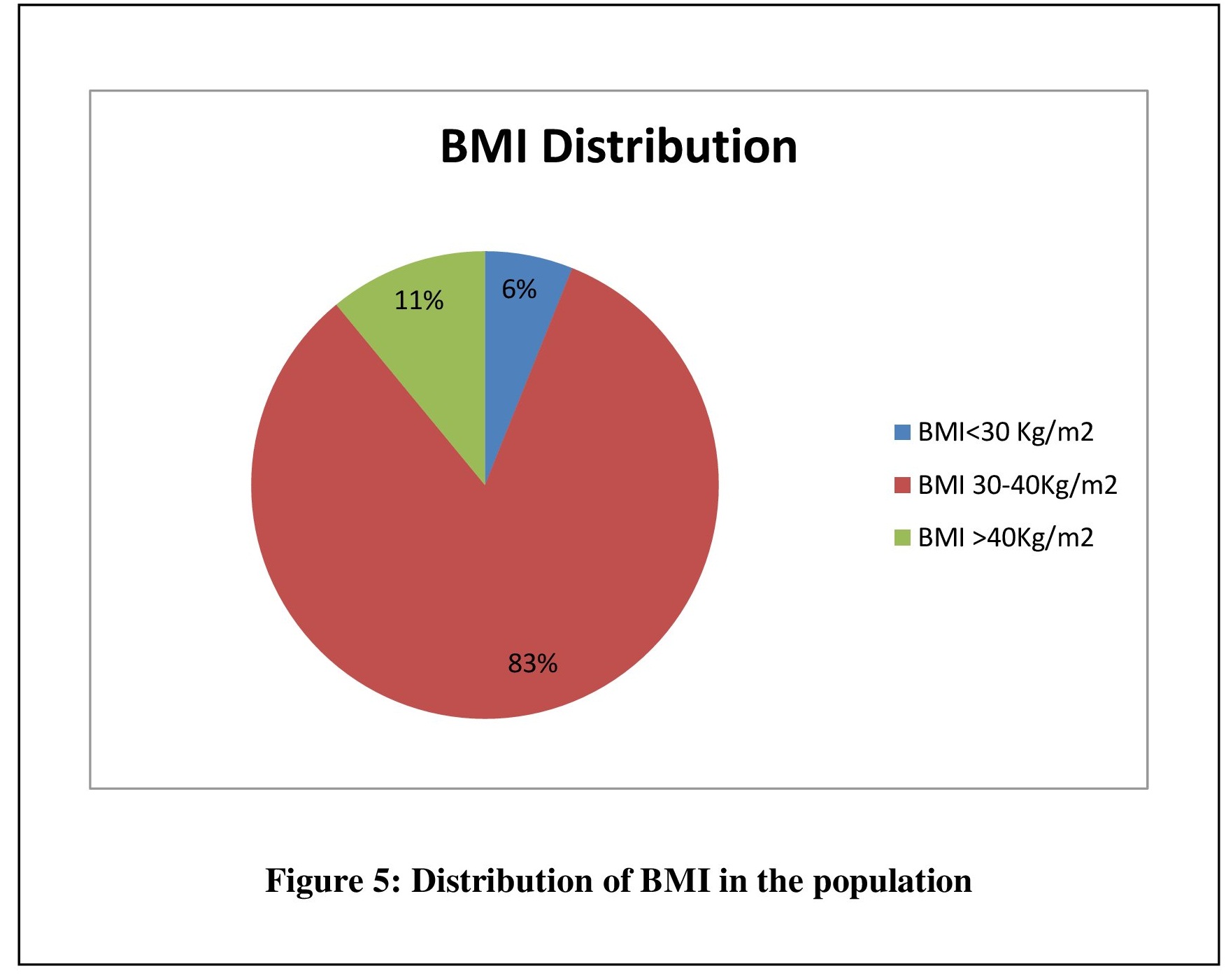Sleeve Gastrectomy with Concomitant Abdominoplasty: A Novel Procedure
Ramakrishnapillai Padmakumar1*, Kumar Abhishek1, Madhukara Pai1, Farish Shams1, Mary Varghese1, Shaji P.G2, Anithadevi T S3, Christeena Jose and Premna Subin1
Affiliation
- 1Department of Laparoscopic and Metabolic Surgery, Sunrise Hospital, Kakkanad, Kochi 682030, India
- 2Department of Anesthesiology, Sunrise Hospital, Kakkanad, Kochi 682030, India
- 3Department of Biostatistics, Sunrise Hospital, Kakkanad, Kochi 682030, India
Corresponding Author
Padmakumar Ramakrishnapillai, Senior Consultant Laparoscopic & Metabolic Surgeon, Director –Minimally Invasive Surgery Institute International (MISII), Department of Laparoscopic and Metabolic Surgery, Sunrise Hospital, Seaport-Airport Road, Kakkanad, Kochi 682030, India, Tel: +91-944-7230370; Fax: +91-484-2428917; E-mail: drrpadmakumar@gmail.com
Citation
Padmakumar R.P., et al. Sleeve Gastrectomy with Concomitant Abdominoplasty: A Novel Procedure. (2016) J Diabetes Obes 3(1): 16- 21.
Copy rights
© 2016 Padmakumar R.P. This is an Open access article distributed under the terms of Creative Commons Attribution 4.0 International License.
Keywords
Obesity; Sleeve gastrectomy; Pfannenstiel incision; Concomitant abdominoplasty
Abstract
Background: Obesity is a major health problem and bariatric surgery has been shown to be the most effective approach in the management of obesity. Abdominoplasty is a common aesthetic procedure for divarication recti with abdominal apron and it has a wide appeal. The aim of this study is to determine the usefulness of laparoscopic sleeve gastrectomy with concomitant abdominoplasty.
Subjects/methods: This is a retrospective study over a 7 - year period from 2009 to 2015, conducted on 82 patients who underwent sleeve gastrectomy and simultaneous abdominoplasty at Sunrise Group of Hospitals, Kochi and Dubai. A classical Pfannenstiel incision was made and the skin flap raised, laparoscopic sleeve gastrectomy carried out with the usual port placement directly on the sheath. Ventral hernia (if present) repaired, neoumbilicus created, redundant skin and fat excised and the flap sutured in layers over suction drains. Patients were followed up indefinitely.
Results: Eighty two patients underwent combined laparoscopic bariatric surgery and abdominoplasty. Of these, 68 (82.93%) had ventral hernia repair carried out and 14 (17.07%) underwent abdominoplasty alone. The median length of stay was 4 days. 6 patients developed postoperative seroma, and 1 patient had surgical site cellulitis; whereas 3 patients developed surgical site infection. To date, one patient required a revision abdominoplasty.
Conclusion: Considering the advantages, comparable hospital stay and the low rate of complications, it would be safe to conclude that LSG with concomitant abdominoplasty is a beneficial procedure in patients of obesity and abdominal apron.
Introduction
Obesity is a major health problem affecting more than 300 million adults worldwide[1]. It is defined as a body mass index greater than 30 kg/m²[2]. It may be associated with abdominal apron. Obesity is a significant risk factor in abdominal hernia occurrence and recurrence[3]. There are number of options available for obese patients to lose weight, but bariatric surgery has been shown to be the most effective and evidence based approach in the management of obesity, it scores better compared to medical treatments in terms of sustainable weight loss[4].
Laparoscopic sleeve gastrectomy (LSG) is a well-accepted surgical procedure in the management of morbid obesity[5]. Approximately one – third of bariatric surgery patients require a body contouring procedure after massive weight loss[6]. Abdominoplasty is a common aesthetic procedure for correcting abdominal apron and has a wide appeal[7]. Many obese patients also have ventral hernia or divarication recti. Proper repair of midline divarication can be achieved with anatomical repair. It is a common practice to place an onlay prosthetic mesh in cases of wide diastasis[8].
Obese patients who have large abdominal apron or ventral hernia need ventral hernia repair and abdominoplasty irrespective of the fact that they are undergoing bariatric procedures. The bariatric procedures will take care of obesity and reduce body fat but not the sagginess, divarication or hernia. Abdominoplasty does not provide significant weight reduction, but it takes care of abdominal apron perfectly. So the procedures are addressing different pathologies. It is the choice of surgeons and patients, whether to tackle both the issues simultaneously or separately.
While we perform the weight reduction procedure, we can perform treatment for the abdominal apron as well. Combining the two procedures will not alter the length of hospital stay. However, there are no clear guidelines as to whether abdominoplasty and ventral hernia repair can be done simultaneously with LSG in patients having both conditions. Combination does not increase the rate of complications. The novelty of this procedure is the flap raising and performing bariatric surgery without any cut on the skin: - Direct trocars on the sheath under the flap. So the only scar will be the scar formed from the cut to perform abdominoplasty; the bariatric surgery is performed scarless.
Methods
This is a retrospective study over a 7- year period from 2009 - 2015 conducted on 82 patients who underwent sleeve gastrectomy and simultaneous abdominoplasty at Sunrise Group of Hospitals, Kochi and Dubai. Sleeve gastrectomy with abdominoplasty is a novel procedure practiced at our center in which sleeve gastrectomy is combined with tummy tuck procedures for better outcomes.
All cases that underwent sleeve gastrectomy and simultaneous abdominoplasty from 2009- 2015 were included in the study. Patients were followed up indefinitely and the following parameters were monitored – length of hospital stay and post-op analgesics, BMI, diabetes status, hemoglobin, serum albumin, incidence of complications, incidence of revision abdominoplasty and the outcomes were analyzed.
Pre-op care
All patients underwent basic bariatric preoperative workup including lab investigations, DEXA (Dual Energy X-ray Absorptiometry) scan, ultrasound of abdomen, ECG and chest x-ray. Consultations with cardiologist, anesthesiologist and dietitian were made for all patients. Nephrology, pulmonology and diabetology consultations were done in those required. Patients were admitted the day prior to surgery. Informed consent for surgery was obtained, explaining the nature and outcome of the procedures. Preoperative antibiotics were given as per recommendations.
Operative technique
The patient is placed in a supine position. A classical Pfannenstiel incision is made and lipodermal flap raised, making the sheath bare till xiphisternum on the upper end and until pubic symphysis on the lower end (Figure 1). The patient’s position is changed to reverse Trendelenburg and laparoscopic sleeve gastrectomy is carried out with port placement on the sheath (Figure 2). Greater omentum is divided close to stomach along the greater curvature, preserving epiploic arcade towards the omentum. A 38 F bougie is then placed per-orally and under its guidance stomach is divided 3 - 5 cm proximal to pylorus, using endostaples, a narrow stomach tube is created and entire fundus is resected. Methylene blue dye is instilled to check gastric leak. After completion of sleeve gastrectomy, ventral hernia (if present) is repaired by either darning or placing a prosthetic mesh (Figure 3). The patient’s hips are flexed to relax the flaps. The redundant skin and fat is excised and quilting sutures are applied. Neoumbilicus is created and the flap sutured in layers over suction drains (Figure 4).
Figure 1: Pre operative view.
Figure 2: Port placement.
Figure 3: Darning.
Figure 4: Closure after dermolipectomy.
Post-op care
Patient will be kept nil by mouth for 24 hours after the procedure. Liquid diet is started at 25 ml/hr, which is gradually increased in the subsequent days. Antibiotics continued for 3 days. Low molecular weight heparin is given once daily for 3 days. Analgesics are given as required - intravenous tramadol, Paracetamol, diclofenac sodium. Patients are ambulated within 24 hours. Breathing and leg exercises are done every 8 hours. Diet counseling is done and patients are discharged on the 3rd postoperative day with a compression garment. They are reviewed after 3 days of discharge, then on 5th day, 14th day, 1 month, 3 months and 1 year interval.
Statistical analysis
Eighty two patients underwent sleeve gastrectomy and simultaneous abdominoplasty. Descriptive statistics were computed on variables such as age, gender and BMI. A pie diagram was used to study the distribution of BMI over time, for the whole population. All of the statistical analyses were performed using Statistical Package for Social Sciences (SPSS) version 19.1 and Microsoft Office Excel 2007.
Results
From 2009 - 2015, 82 patients underwent laparoscopic sleeve gastrectomy with abdominoplasty. There were 73 (89.02%) female patients and 9 (10.98%) male patients with a mean age of 42 years (range from 30 - 59 years). The mean preoperative BMI 35.9 kg/m² (range from 28 to 49.6 kg/m²) with five patients having BMI < 30 kg/m² (6%) , 68 patients having BMI between 30 - 40 kg/m² (83%) and 9 patients having BMI > 40 kg/m² (11%) (Figure 5).
Figure 5: Distribution of BMI in population.
Type II Diabetes Mellitus (T2DM) was seen in 36 patients (51.4%), with 26 patients (37.14%) having BMI between 30 – 40 kg/m² and 5 patients (7.14%) having BMI > 40 kg/m². The mean Hb was 12.24 mg% (range from 8.3 - 14.5 mg %) with 5 patients (7.14%) having Hb < 10mg%. The mean serum albumin levels were 3.40 g/dL (range from 3.2 to 5.1).
Sixty eight patients (82.93%) had an associated ventral hernia and a prosthetic mesh was used for repair in 14 patients (17.07%). The patients had median postoperative stay of 4 days (range from 2 to 15 days). Postoperative analgesic use was for a mean of 4 days (range from 2 to 10 days).
Seroma developed in 7 patients (10%). One patient (1.43%) had minimal wound dehiscence, which was associated with wound infection. That patient required a revision abdominoplasty, which was performed after 14 months. One patient (1.43%) developed cellulitis whereas 3 patients (4.3%) had surgical site infection (Table 1). Those patients with large seroma were managed with aspiration of the collection. Cellulitis was managed conservatively with antibiotics. Those with surgical site infection required drainage and antibiotics.
Table 1:
| Complications | Number | T2DM | BMI | |||
|---|---|---|---|---|---|---|
| + | - | < 30 | 30 - 40 | >40 | ||
| Seroma | 7(10%) | 7(10%) | - | 1(1.43%) | 5(7.14%) | 1(1.43%) |
| Dehiscence | 1(1.43%) | 1(1.43%) | - | - | 1(1.43%) | - |
| Cellulitis | 1(1.43%) | 1(1.43%) | - | - | 1(1.43%) | - |
| Infection | 3(4.28%) | 1(1.43%) | 2(2. 8%) | - | 3(4.28%) | - |
| Revision abdominoplasty | 1(1.43%) | 1(1.43%) | - | - | 1(1.43%) | - |
None of the patients in this study had mesh infection or rejection and none developed a recurrent hernia. There was no mortality in the study group.
Discussion
Obesity is a common worldwide disease[1] and is also an important precipitating factor for primary and recurrent ventral hernias (incisional and umbilical)[9]. It is not uncommon to find hernias in patients opting for obesity surgery[3]. Laparoscopic sleeve gastrectomy is an effective procedure for the treatment of obesity[5]. About one-third of bariatric surgery patients require a body shaping procedure after massive weight loss[6] and this type of body contouring has grown concomitantly with the popularity of bariatric surgery[10] Abdominoplasty is the most commonly performed aesthetic procedure. Careful patient selection, optimization and correct technique reduce the complication rates considerably[8].
Abdominal apron does not get corrected with LSG and weight reduction will not happen with abdominoplasty. By combining LSG with abdominoplasty - we can avoid a second surgery, anesthesia for the second procedure, and the external scars for sleeve gastrectomy. It also offers immediate results in regards to the true problems faced by patient: - obesity and abdominal apron. Sleeve gastrectomy is performed using endoscopic staplers and hence there is no spillage of bowel contents. It can be considered as a clean or clean contaminated surgery. Sleeve gastrectomy specimen is removed after placing it in a custom made endobag to further reduce possible contamination.
The surgeon’s preference and easiness of abdominoplasty due to the reduced weight following bariatric surgery are the reasons for performing aesthetic procedures at a later date. In many occasions patients undergo abdominoplasty alone due to the lack of proper motivation by surgeon regarding weight reduction surgery. It may be because of patient’s unwillingness also. Patients need to be counseled that tummy tuck procedure will not produce significant weight reduction and bariatric procedure will not make significant improvement of ventral hernia or saggy abdomen.
Hospital stay
In the present study, the median postoperative stay was 4 days (range 2 to 15 days). In the series by Palol g et al, the median postoperative hospital stay was 4.0 days (range from 3 to 62 days) in the first 84 cases and 3.0 days (range from 3 to 28 days) in the last 116 cases following sleeve gastrectomy[4]. Whereas in patients undergoing concomitant abdominoplasty with ventral hernia repair, median length of hospital stay was found to be 3 days (range from 1 to 7 days) in a report - Andrew S et al[11].
Complications
A complication is any unforeseen event that either adversely affects the outcome of the procedure or delays the recovery or necessitates additional procedure to correct the problem[8]. Rangaswamy M; in his review of 445 articles on abdominoplasty found that the common complications reported were seroma, necrosis, hematoma, infection wound healing problems and venous thromboembolism. Less commonly reported complications include chest complications, umbilical numbness, extensive skin loss, necrotizing fasciitis, abdominal compartment syndrome, reflux esophagitis, peritoneal perforation, myocardial infarctions and death[8]. Neaman et al reported the overall complication rates of 37.4% in a retrospective review of 206 consecutive patients who had undergone abdominoplasty. Major complications where reported in 16 % of patients whereas the rate of minor complications was 26.7%[12]. In the present study the rate of complications was 12.8%.
Seroma: It is one of the most common complications reported[13,14] and it defined as a localized collection of serous or serohemorrhagic fluid that is detected clinically or radiologically irrespective of the need for evacuation. The rate varies from 0.1% to 42%[15]. Seromas usually form when there is lack of adhesion between a flap and the underlying tissues and the risk of seroma is increased by shearing movements[8]. Baroudi and Ferreira proposed routine use of quilting sutures based on a 5-year experience with zero seroma rate in 130 patients[16]. Various studies showed seroma formation rates as 16% 12 or 12.5%[13], whereas, the present study has a rate of 10%.
Infection: Chan DL et al reported mesh infection in 2 out of 45 (4.5%) patients who underwent laparoscopic bariatric surgery with abdominal wall hernia repair[3]. Shermak et al reported 7.5% suture abscess[17], Andrew S et al.[11] reported infection in 29 patients which required debridement. Karem C et al reported a 5 fold increase in risk of a wound complication in patients with panniculectomy[14]. In the present study, 3 (4.3%) patients developed wound infection. Wound infection is often multifactorial. It can be minimized by eliminating co- existing foci of infection elsewhere, following good aseptic technique and paying meticulous attention to minimize tissue trauma[4].
Recurrence/ Mesh removal: Karem C et al reported a recurrence rate of 10% in their study 14, whereas, various studies showed no recurrence or mesh removal[3,9,11]. The present study also does not report any recurrence or mesh removal.
BMI related problems: In Rogliani et al series of 82 patients of abdominoplasty, the following observations were made. 76% of obese patients developed complications, whereas, overweight patients had 35% and normal-weight patients had 33% complications only[18]. A retrospective study was conducted by Karem C et al on 30 morbidly obese patients undergoing open complex abdominal wall reconstruction. Twenty underwent simultaneous panniculectomy. It was observed that performing a panniculectomy increased the risk for a wound complication by 5-fold[19]. The present study reports a complication rate of 11.4% in obese patients, whereas, only one of the morbidly obese patient had a complication.
It was also observed during the study, the procedure becomes technically challenging due to the weight of the abdominal apron. Generally body contouring procedures are done after significant weight reduction as a second sitting. We observed that when BMI < 40 kg/m² these procedures can be combined comfortably and presently we are restricting concomitant procedures to this group, combining these will not have any adverse effect.
DM: Diabetic patients have not shown a higher rate of infection after abdominoplasty[20]. Two (2.8%) patients with wound infection were non diabetics. However, it is important that diabetic patients attain the best optimization of their diabetic status prior to surgery.
Conclusion
Considering the advantages, comparable hospital stay and the low rate of complications, it would be safe to conclude that LSG with concomitant abdominoplasty is a beneficial procedure in patients of obesity with abdominal apron.
Acknowledgement:
We are extremely thankful to Dr. Hafeez Rahman, Chairman and Ms. Parveen Hafeez, Managing Director Sunrise Group of Hospitals, Kakkanad, Cochin, India, for permitting us to conduct this study. We are thankful to Mr. Rojo T J, Head of the Department of Medical records for providing the details of the patients.
Conflict of Interest:
There were no conflicts of interest.
References
- 1. Deitel, M. Overweight and obesity worldwide now estimated to involve 1.7 billion people. (2003) Obes Surg 13(3): 329-330.
- 2. Sarkosh, K., Daniel, W.B., Arya, S., et al. Complications associated with laparoscopic sleeve gastrectomy for morbid obesity: a surgeon’s guide. (2013) Can J Surg 56(5): 347-352.
- 3. Chan, D.L., Talbot, M.L., Chen, Z., et al. Simultaneous ventral hernia repair in bariatric surgery. (2014) ANZ J Surg 84 (7-8): 581-583.
- 4. Paolo, G. Laparoscopic Sleeve Gastrectomy as a Primary Operation for Morbid Obesity: Experience with 200 Patients. (2012) Gastroenterology Res Pract 2012.
- 5. Moon, H.S., Kim, W.W., Oh, J.H. Results of laparoscopic sleeve gastrectomy (LSG) at 1 year in morbidly obese Korean patients. (2005) Obese Surg 15(14): 1469-1475.
- 6. Abela, C., Stevens, T., Reddy, M., et al. A multidisciplinary approach to post-bariatric plastic surgery. (2011) Int J Surg 9(1): 29-35.
- 7. Matarasso, A., Swift, R.W., Rankin, M. Abdominoplasty and abdominal contour surgery: A national plastic surgery survey. (2006) Plast Reconstr Surg 117(1): 1797-1808.
- 8. Mohan, R. Minimising complications in abdominoplasty: An approach based on the root cause analysis and focused preventive steps. (2013) Indian J Plast Surg 46(2): 365-376.
- 9. Praveen Raj, P., Senthilnathan, P., Kumaravel, R., et al. Concomitant laparoscopic ventral hernia mesh repair and bariatric surgery: a retrospective study from a tertiary care center. (2012) Obese Surg 22(5): 685-689.
- 10. American Society of Plastic Surgery. Body contouring after massive weight loss.
- 11. Saxe, A., Schwartz, S., Gallardo, L., et al. Simultaneous Panniculectomy and Ventral Hernia Repair Following Weight Reduction after Gastric Bypass Surgery: Is it Safe? (2008) Obes Surg 18(2): 192-195.
- 12. Neaman, K, C. Hansen, J,E. Analysis of complications From Abdominoplasty: A Review of 206 Cases at a University Hospital. (2007) Ann Plast Surg 58(3): 292-298.
- 13. Baroudi, R., Ferreira, C.A. Seroma: How to avoid it and how to treat it. (1998) Aesthet Surg J 18(4): 439-441.
- 14. Pollock, T.A., Pollock, H. Progressive tension sutures in abdominoplasty: A review of 597 consecutive cases. (2012) Aesthet Surg J 32(6): 729-742.
- 15. Andrades, P., Prado, A., Danilla, S., et al. Progressive tension sutures in the prevention of postabdominoplasty seroma: A prospective, randomized, double-blind clinical trial. (2007) Plast Reconstr Surg 120(4): 935-946.
- 16. Roje, Z., Karanoviae, N., Utrobiciae, I. Abdominoplasty complications: A comprehensive approach for the treatmentof chronic seroma with pseudobursa. (2006) Aesthetic Plast Surg 30(5): 611-615.
- 17. Karthikesalingam, A., Kitcat, M., Malata, C.M. Abdominoplasty in patients with and without pre-existing scars: A retrospective comparison. (2011) J Plast Reconstr Aesthet Surg 64(3): 369-374.
- 18. Rogliani, M. Silvi, E., Labardi, L., et al. Obese and Nonobese Patients: Complications of Abdominoplasty. (2006) Ann Plast Surg 57(3): 336-338.
- 19. Harth, K.C., Blatnik, J.A., Rosen, M.J. Optimum repair for massive ventral hernias in the morbidly obese patient__is panniculectomy helpful? (2011) Am j surg 201(3): 396-400.
- 20. Shemak, M.A. Hernia Repair and Abdominoplasty in Gastric Bypass Patients. (2006) Plast Reconstr Surg 117(4): 1145 -1150.


